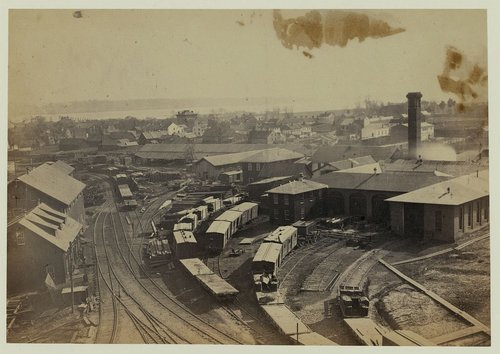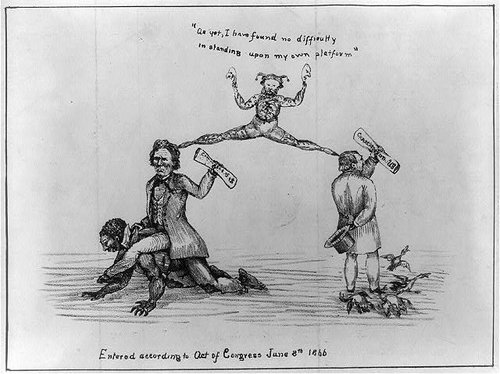Student Work
Railroads and Economy
By: Helena Howell

Bird’s eye view of machine shops, with east yard of Orange & Alexandria Railroad
Library of Congress Prints and Photographs Division Washington, D.C. 20540 USA http://hdl.loc.gov/loc.pnp/pp.print
The Reconstruction Era: Railroads and Economy
The Post-Civil War Reconstruction Era is one of the most widely misinterpreted eras in American history in terms of the progress of the post-Confederacy South. A resentment of the Northern political effort to make the South more “northern” [1] was evident in the political atmosphere of Reconstruction era efforts. In order to reinterpret the success of Southerners in an economic perspective, a deeper look into the Neilson’s archival collection of correspondence letters written by the department store owner is useful. These two letters are from the correspondences between the Neilson’s Department Store and locals in the Oxford area. The Neilson’s department store owner corresponded with two families in particular in a desire to fix accounting records of items which they had purchased for the store. These letters, having been written after the Civil War, indicate a general concern over the reconstruction era. In the first letter, Mr. Neilson addresses being charged too much for items he purchases such as work hats. The financial concern that underlies the exchange in funds was an issue which confronted businessmen all across the South.
In addressing these financial concerns, businesses such as Neilson’s sent various letters and notices to locals asking for clarification about records such as the ones seen here [2]. Various goods like the shoes and hats mentioned in these letters would have been highly valuable at the time as they showed that basic necessity items were in demand during an era of economic stress. A crucial part of transportation of these items was the railroad. While the economy suffered initially, Neilson’s was one of the first stores to reopen after Oxford had suffered fire damage during the Civil War. The movement of product through the south via railway was crucial to the economic wealth and prosperity of Southern business owners [3]. While the importance of the railroad is not introduced in these letters, my fellow classmates and I find it greatly important to include this information for a greater picture of the Reconstruction and how it influenced business correspondence in the South.
President Johnson at the time of Reconstruction and directly following the war, gave much credit to these railroads as a possibility for getting the South back on track; this period was later coined as the Presidential Reconstruction. Shortly thereafter, he received harsh criticism from Southern conservative Congress members who argued that Reconstruction should be managed by the state rather than the federal government. This cartoon [4] below shows Reconstruction era conflict between Congressman Thaddeus Stevens and Andrew Johnson. Thaddeus was unwilling to budge on his position that Southern states had the right to reconstruct themselves, while Andrew Johnson believed only Congressional power could do it. As a result, Congressional Reconstruction took hold and the management of the railroads became largely privatized and rapidly advanced the South’s economy [5].

Published in 1866, American cartoon print filing series (Library of Congress)
https://www.loc.gov/item/2008661695/
The railroad was key to the development and sustainability of southern businesses who connected their main sources of business to major northern port cities. One such of these organizations was the U.S. Military Railroad Construction Corps[6] and the Seaboard Inland Airline. While the Military Construction Corp began expanding railroads in 1863, they paved the way for the post-war railroad industry boom. This railroad specifically having been largely privatized was an easy way for Southern congressmen who didn’t agree on Congressional or Presidential Reconstruction to evade federal control. Ultimately, this brought Southern business owners together in a way unlike before, and reshaped the Southern economy. Not only were goods distributed between the North and South, but goods being sold at Neilson’s such as cigars and tobacco products could readily be transported through the “Upper South”[7] to the “Lower South”[8].
Finally, this new form of transportation across the country became a source of staple items that became part of the larger regional identity of Southern stores[9]. Neilson’s department store was part of this larger regional identity in that it reflected the goods being transported across the country at this time and helped shape Oxford’s business story.
Ledger 1, Blotter Correspondence from Neilson’s Collection, Department of Archives and Special Collections, The University of Mississippi Libraries.
Railroads and Economy
[1] Remillard, Arthur. Southern Civil Religions : Imagining the Good Society in the Post-Reconstruction ERA. Athens: University of Georgia Press, 2011. Accessed January 7, 2019, 17, ProQuest Ebook Central..
[2]Neilson’s Collection: Miscellaneous ledgers: Ledger 1, Blotter Correspondence, December 16th, 1870, J.D. Williams Library Archives and Special Collections.
[3] Nelson, Scott Reynolds. Iron confederacies : southern railways, Klan violence, and Reconstruction. Chapel Hill ; London : University of North Carolina Press, 1999.
[4] Published in 1866, American cartoon print filing series (Library of Congress) https://www.loc.gov/item/2008661695/
[5] Nelson, 49-53.
[6] Nelson, 52-53
[7] Nelson, 53.
[8] ibid.
[9] Nelson, 64.
